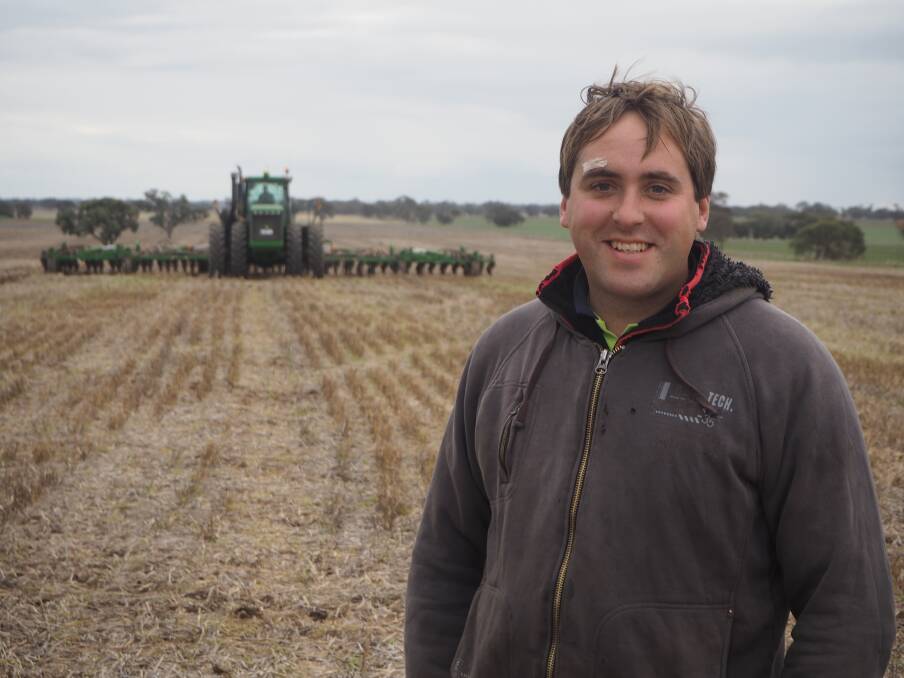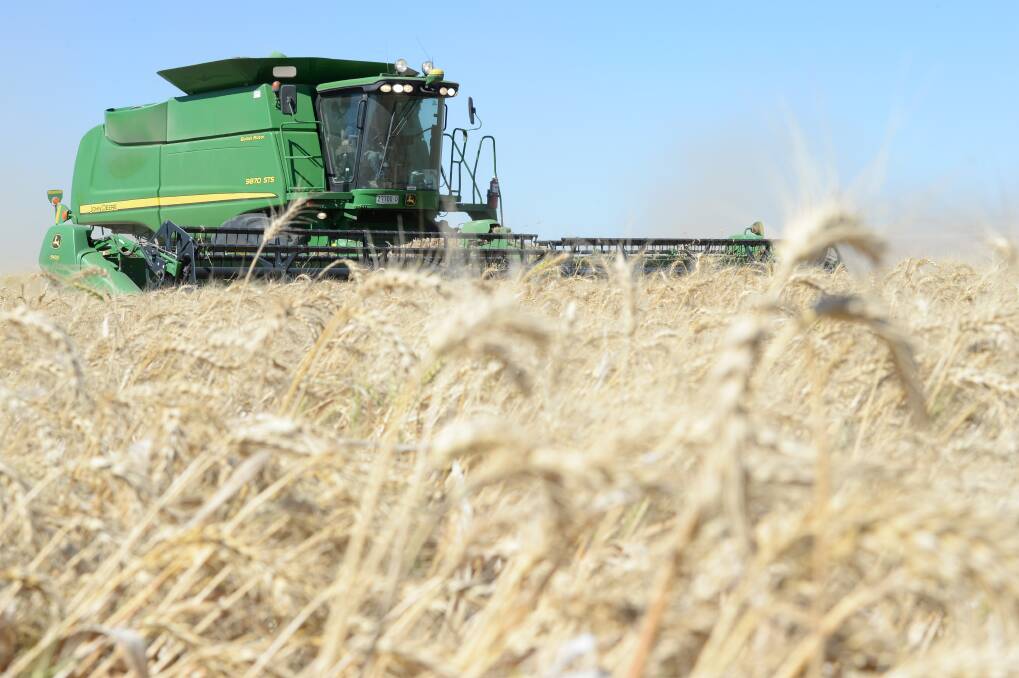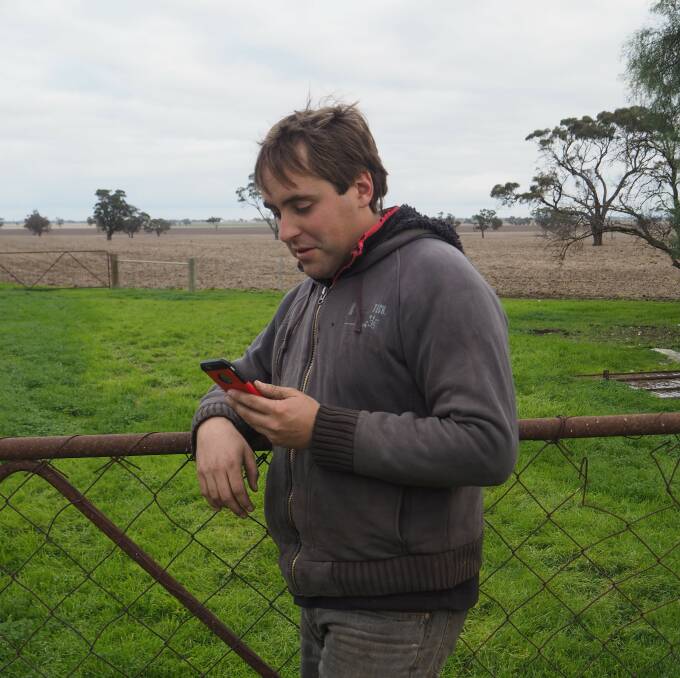Data yields rich results

This article is sponsored by Rabobank
When you talk of using data in cropping systems, the conversation usually drifts towards agronomic matters.

Use of data to allow variable rate fertiliser application, particularly soil ameliorants, and chemical application, has led to some impressive savings in input costs.
Jonathan Dyer, Kaniva, in the far western Wimmera, hopes to see data collection allow his family farming business to extract a quality premium for their grain.
Mr Dyer, who farms “Tooronga” with his wife Tiarnee, father Alwyn and uncle Eric, is using real time crop quality information to help segregate wheat.
“We’ve got an on-header protein meter from a company based in Sydney, Next Instruments, which works using near infrared (NIR) technology,” said Mr Dyer, who used a Nuffield Scholarship to investigate big data and agriculture.
“It was upgraded on the harvester for about $15,000 with a view to learning more about crop quality, where protein is higher, or lower, around the farm and perhaps making that work for us.”
RAPID DIVIDEND
The payoff came faster than expected, with climatic conditions meaning there were marked intra-paddock differences in protein results last harvest.
“Using the meter, we were able to separate parcels of higher and lower protein wheat and store them accordingly,” Mr Dyer said.
With substantial price premiums available for higher protein bread wheat the family was able to target the higher paying APW and H1 segregations with wheat from the flats.
“It was a textbook year for doing something like this.”
“There were patches of frost on the low lying flats in the paddock, where yield was markedly lower, but protein was much higher.
“Doing tiller counts in the spring, the yield potential was massive – up to eight tonnes a hectare – so we fed the crop accordingly with nitrogen.
“But the yield ended up only around 3t/ha, so it was no surprise to see those high protein levels.
“On the hills yields were nearly double that, but protein was well down.
“If we’d harvested it all together the wheat would have made ASW standard and we would have missed out on the premiums.”
The family created rough protein level maps by doing sample harvest strips, then harvested the paddock using two headers. One concentrated on the flats and the other did the hills.

The premium for APW was around $30/t for much of the early part of this year.
“There is always someone making money from blending opportunities with different market requirements and we thought it might as well be us,” he said.
This has led the Dyers to invest substantially in on-farm storage, allowing them to market grain off-farm to various domestic processors and grain exporters.
“We’ve got a lot of sealed storage here and we’re comfortable storing our grain for a year and out-turning it to high quality specifications,” Mr Dyer said.
“This year, the silos are storing wheat of varying protein levels.
“It means we only needed to get a higher segregation on 150 tons of wheat and the protein meter has returned 15 per cent in a year. We were able to do a lot more than that. It's pretty rare to see such a high return on a farm technology investment straight away.”
Frost acted as the joker in the pack this year.
“We wouldn’t normally expect such clear cut results, but it is interesting to see what can happen when you get real-time data like this.”
As much success as they had using the protein meter to segregate bread wheat, the family initially expected it to have more application in the durum crop.
“Protein in durum is quite tricky to manage and it's pretty important to hit your specifications,” Mr Dyer said.
“You don’t have the marketing options you have with bread wheat and if you fall under 10.5pc protein you're at feed grain prices.
“There’s a substantial discount.”
The Dyers farm 2200ha across 40 kilometres, on a nominal average rainfall of 450 millimetres, which has dropped to 400mm in the past 20 years.
They grow a mixture of bread and durum wheat, canola, lentils, faba beans and chickpeas in a continuous cropping rotation.
PROFITABLE DATA
Mr Dyer’s interest in data came from a desire to find an edge to help the farm business stay profitable.
“You look at other grain producers (overseas) and they’re a lot lower cost than us, and in places like the Black Sea their costs could come down further again if the logistics improve.”
This prompted him in using data to help develop new opportunities.
“We’re faced with a difficult climate and high cost of production so we need to not only use data and precision agriculture (PA) to help cut costs, but also perhaps allow us to target premiums,” he said.
His farm business had already evolved significantly in the past 20 years.
“I’m of a generation where I have never cultivated, I’ve never manually steered a tractor out of necessity.”
“We’ve already made those changes and are looking for the next round of improvements,” he said.
There was a broad range of data collection services to help the farm business throughout the growing and marketing process.

“It’s now possible to collect large amounts of data on-farm at very little cost.”
“Examples include weather data, harvest yield information, soil type maps, soil moisture and temperature probes and machinery performance data.
“The trick can be in using the data together to get those correlations to help you either make savings or create extra profit.”
“For example, if you can easily see where yields in paddocks drop off and then contrast them against a soil type, you might find something is wrong in one particular spot,” Mr Dyer said.
However cost and connectivity were two issues holding the business back from embracing more data use.
“For soil tests the cost is markedly different to what I saw in North and South America as part of the Nuffield Scholarship.”
“It does have an impact on how much information you can gather – ideally we’d do a bit more, but it gets expensive.”
The well-documented woes with connectivity and mobile service are also a constraint.
“We don’t have the NBN coming to Kaniva at present and we’re looking at options like private networks to see what’s feasible – we really don’t want to be left behind on this front,” Mr Dyer said.
DIVERSITY REWARDS
“I think Australian growers will gradually diversify their cropping programs further – we already see it in terms of increased pulse and oilseed plantings, but overall cereals still dominate,” Mr Dyer said.
Mr Dyer felt pulses were good options for his area.
“We’ve had some of our best gross margins from crops such as lentils, chickpeas and even faba beans, which currently are not so well priced.”
“I like the idea of pulses in the rotation.
“Look where they originate, from semi-arid environments in the Middle East. They’re very efficient foragers for moisture which suits our environment.”
“This becomes even more pronounced if prices stay somewhere near the current highs.
“What is a risky crop at $400/t becomes a much safer proposition at $1000/t.
“With current pulse prices you could have a break-even point as low as 250kg/ha,” Mr Dyer said.
He sees a fit for the NIR technology used to good effect in the protein meter in the pulse side of business.
“Pulses are very much a visual crop in terms of marketing, colour is very important to buyers, and using the NIR technology we have we may be able to better grade them and extract premiums,” he said.
Soil types vary markedly from classic self-mulching black clay to loamy red soils to sandy rises.
They grow a mixture of bread and durum wheat, canola, lentils, faba beans and chickpeas in a continuous cropping rotation.
This article is sponsored by Rabobank


